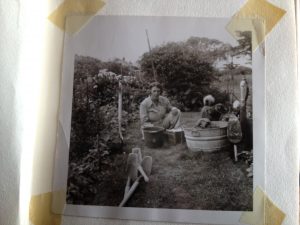
If you look at the cover of Lady on the Beach, by Norah Berg with Charles Samuels, you might think you know the kind of book it is: sentimental, inspirational, dated. That’s what I thought, too, especially when I considered the copyright date — 1952 — and read the phrase “miracle of love” on the back cover. But I was at the beach and it seemed apt to be a lady on the beach reading Lady on the Beach.
Seven pages in, you learn the reason the author and her husband moved to their tiny beach community: “A double drinking problem we’d been unable to cope with had turned us into drifters, tormented by guilt and a shame shapeless as fog and as difficult to wrestle with.” The beach doesn’t magically solve that problem. It does, however, provide razor clams, driftwood to make into furniture or burn as fuel, and neighbors:
Among our Ocean City neighbors are many middle-aged folks who have spent their lives gathering the fruit around Oregon and Washington State. They come down here each fall, when the harvests are all in, to wait for spring. On becoming too feeble to follow the fruit, they retire here to live on their old-age pensions.
A few of our neighbors at one time or another have been in prisons or mental hospitals. Others, including some of the younger men and women, came here to escape homes where they’d found no love. More, though, were misfits in the city, and are the human rejects of industry who proved unable or unwilling to adjust themselves to the harness, the checkrein, and blinders everyone must wear in a factory, a mill, or an office.
In fact this is a kind of book that I love: a clear-eyed portrait of a particular time and place, where you come to understand the people by learning how they survive their various challenges in a setting of dramatic natural beauty that can also be dangerous.
This photo was taped into the copy of the book I read. We’re pretty sure it’s the author.

